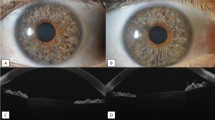Abstract
Purpose
We evaluated a new concept for treating pupillary capture of the intraocular lens (IOL) following intrascleral fixation of the IOL. Pupillary capture of the IOL is a common postoperative complication that occurs after suturing and intrascleral fixation of the IOL. In such cases, blunt trauma is often related to zonular dialysis, iris retraction, iridodonesis, and angle recession. Several methods such as barricading by suturing, pupilloplasty, and pars plana fixation are reported to prevent pupillary capture. Although effective, none of these techniques fix iris-malposition and angle recession. We considered that repairing angle recession could correct the iris position and prevent pupillary capture recurrence.
Methods
We repaired angle recession in four cases and have followed up.
Results
Pupillary capture was not observed in all three cases of larger IOLs for more than 9 months, but observed after 1 month in an IOL with normal 6 mm diameter, in which the angle was not properly lifted.
Conclusion
In select cases, repairing angle recession may be useful for preventing pupillary capture after IOL suturing and intrascleral fixation.





Similar content being viewed by others
References
Bum-J HG (2014) Surgical outcomes according to vitreous management after scleral fixation of posterior chamber intraocular lenses. Retina 34:1977–1984
Herschler J (1977) Trabecular damage due to blunt anterior segment injury and its relationship to traumatic glaucoma. Trans Sect Ophthalmol Am Acad Ophthalmol Otolaryngol 83:239–248
Blanton FM (1964) Anterior chamber angle recession and secondary glaucoma: a study of the after effects of traumatic hyphemas. Arch Ophthalmol 72:39–44
Loo AV, Lai JS, Tham CC, Lam DS (2002) Traumatic subluxation causing variable position of the crystalline lens. J Cataract Refract Surg 28(6):1077–1079
Bang SP, Joo CK, Jun JH (2017) Reverse pupillary block after implantation of a scleral-sutured posterior chamber intraocular lens: a retrospective, open study. BMC Ophthalmol 17(1):35
Lindstrom RL, Herman WK (1983) Pupil capture: prevention and management. J Am Intraocu Implant Soc 9:201–204
Yoo YJ, Kim ET, Heo JW (2016) Safety barricade suture for preventing pupillary capture of intraocular lens with scleral fixation: H-technique. Retina 36:206–210
Sung IK, Kiseok K (2016) Tram-track suture technique for pupillary capture of a scleral fixated intraocular lens. Case Rep Ophthalmol 7:290–295
Fanglu H, Wei L, Xiangwei S, Ruili T, Qiang J, Xiangjuan Z (2014) Evaluation of pars plana sclera fixation of posterior chamber intraocular lens. Indian J Ophthalmol 62:688–691
Narang P, Agarwal A (2017) Pupilloplasty for pupil size attenuation to prevent pupillary capture: theory of quintet in glued IOL. J Cataract Refract Surg 43(1):3–7
Can E, Gul A (2016) A safe method of ciliary sulcus fixation of foldable intraocular lens using a ciliary sulcus guide. Int Opthalmol 36:463–468
Acknowledgements
The studies have been approved by the institutional ethics committee and have been performed in accordance with the ethical standards as laid down in the 1964 Declaration of Helsinki and its later amendments or comparable ethical standards. Patients have consented to the usage of pictures and videos in this paper and the publication of the case reports to the journal.
Author information
Authors and Affiliations
Corresponding author
Ethics declarations
Conflict of interest
M. Akimoto is a consultant at Kowa Co. Ltd. No conflicting relationship exists for any other author.
Additional information
Meeting presentation: The 71st annual congress of Japan Clinical Ophthalmology, Tokyo, Japan, October 2017.
Electronic supplementary material
Below is the link to the electronic supplementary material.
This video demonstrates the representative technique for suturing the iris root (MOV 51355 kb)
Rights and permissions
About this article
Cite this article
Kujime, Y., Akimoto, M. Repair of angle recession prevents pupillary capture of intrasclerally fixed intraocular lenses. Int Ophthalmol 39, 1163–1168 (2019). https://doi.org/10.1007/s10792-018-0911-5
Received:
Accepted:
Published:
Issue Date:
DOI: https://doi.org/10.1007/s10792-018-0911-5




